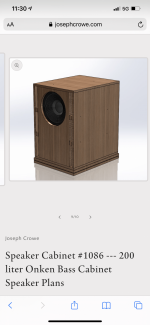Jerico,
You will find many builds. What is special is the arrangement of the vents. The rote formulas that are often used are essentially a low bass shelf alignment. But more people are using the vents but tuning them flatter, or as in my miniOnkens, pat no attention to the classic alignemnt and use something quite differemt (quality over quantity).
dave
You will find many builds. What is special is the arrangement of the vents. The rote formulas that are often used are essentially a low bass shelf alignment. But more people are using the vents but tuning them flatter, or as in my miniOnkens, pat no attention to the classic alignemnt and use something quite differemt (quality over quantity).
dave
Easier to design one than try and figure out what driver(s) it's designed for, so if wanting this particular size, then choose the driver that has specs that calcs 200 L = Vas*Qts^2*'n' where Onken alignment = 6.34, T/S max flat = 5.7
Hmm, here's the math and at a glance don't see how it can calc one with any drivers we're likely to use and BTW, I vetted this calculator some time ago and its all correct, including having the Snyder alignment used for Hiraga's Onkens:The rote formulas that are often used are essentially a low bass shelf alignment.
Vb = n*Vas*Qts^2
n = 6.34 Onken
n = 5.7 T/S max flat
Fb = 0.39*(Fs/Qts')
[Qts']: [Qts] + any added series resistance [Rs]: http://www.mh-audio.nl/Calculators/newqts.html
Sorry can you do an example?Hmm, here's the math and at a glance don't see how it can calc one with any drivers we're likely to use and BTW, I vetted this calculator some time ago and its all correct, including having the Snyder alignment used for Hiraga's Onkens:
Vb = n*Vas*Qts^2
n = 6.34 Onken
n = 5.7 T/S max flat
Fb = 0.39*(Fs/Qts')
[Qts']: [Qts] + any added series resistance [Rs]: http://www.mh-audio.nl/Calculators/newqts.html
Could you provide some details on how the mini-Onken alignment is different? What might a typical response curve look like?...or as in my miniOnkens, pat no attention to the classic alignemnt and use something quite differemt (quality over quantity).
Pretty flat. But the sims do not account for the added vent R, so one aims for a small bump just before rolloff (unless you are tuning the box very low). The bump is knocked down due to the extra ventR.
The other rule is that the first derivative of the FR curve should only cross zero once (or none if tuning low). This criteria dictates a maximum size. It tends to be smaller than people expect.
dave
The other rule is that the first derivative of the FR curve should only cross zero once (or none if tuning low). This criteria dictates a maximum size. It tends to be smaller than people expect.
dave
No clue what alignment is used for the mini, but the Onken, Bessel, pioneer's prosound alignments will all yield the no crossing requirement and the mini's damped vents can be replicated with a single large vent that's been critically damped, though not necessarily sound the same or even the same among those listed, yet short of A/B comparisons, just know that each are fine performers WRT pace, rhythm and timing (PRaT), power handling.Could you provide some details on how the mini-Onken alignment is different? What might a typical response curve look like?
Bessel [QL3]: https://www.petoindominique.fr/php/mysql_multibessel3.php
Vb = 8.0707*Vas*Qts'^2.5848
Fb = 0.3352*Fs*Qts'^-0.9549
Pioneer's pro sound:
Vb = Vas/1.44
Fb = 1.56x Fs
Critical damping:
Click Test:
- Home
- Loudspeakers
- Multi-Way
- Onken 200L
